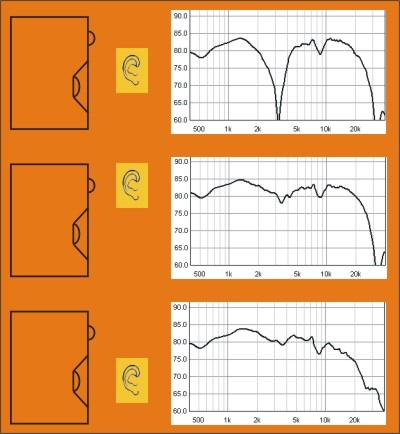[Products]
[Press + Media]
[Basics]
[Technology]
[Application]
[Shop]
[FAQ]
[Contact]
[Links]
[Site Notice]
What are the advantages of coaxial design of loudspeaker chassis?
The main advantages of coaxial technology can be found in the time:
- The auditory centers of tweeter and woofer are on one level.
- Therefore the relative position of the auditory centers to the listener does not change, if he changes his position.
|
On a multi-way loudspeaker, the resulting effects are particularly evident if the listener (or the measurement microphone) is moving in the axis of the driver, usually from the bottom up (and vice versa), which is rarely recorded by published measurements. Due to the relative shifts of the auditory centers we have -at some angles in the transfer area- between woofer and tweeter perfect additions, while in othersangles, perfect eliminations. IIn the crossover you can react to such effects, but only exactly on one angle. And this usually means worse results on the other angles. An optimization over the whole radiation area is not possible in this way, even with sophisticated digital switches. The same effects work of course, in less pronounced intensity, in the vertical plane and in any other direction. |
frequency responses in different listening positions with discrete systems |
Why is this effect so important for the listening experience ?
Fundamental for the listening experience, the balance and spatial representation is on the one hand the direct sound, and the other hand the reflected sound across the room (walls, objects).
The direct sound from a driver, which comes close to the ideal of the point source, shows a more similar behaviour under different angels as two or more discrete drivers - the tonal balance isnīt influenced so much, the sound becomes more homogeneous and more clearly. Therefore it is also possible to design an ideal flat response with the crossover, without disadvantage for other listening angles. Because the indirect sound (by reflections) is generated more uniformly, the reflections are more homogeneous and much more similar to the direct sound.
While the human brain is partially able to compensate the negative tonal results, the negative effects oft the time component are serious:
As our listening sense is constructed to discover informations about direction and distance out of minimal time shifts of milli or microseconds, a point source with their essentially more homogenous time response produces a much more accurate illusion of the real event. For this reason fullrange drivers became very popular, even if they show often considerable tonal weaknesses - her timing is superior to discrete multi-way systems. Did you ever wonder why the newscaster often sounds more realistic coming out of a cheap fullrange " hooter" than out of big and expensive multi-way speakers?
But the disadvantages of coaxial technology donīt have to be kept back:
While the tweeter of a (discrete) multi-way loudspeaker “looks” at a fixed (ideally) favourable environment, many coaxial structures are fighting with the moving and relatively unfavourable formed environment in the shape of the bass / mid cone. The basic idea behind the development of the Audio Consequence coaxial driver was to make this environment for the tweeter in a way that it is'nt influenced in its frequency response. At the same time the requirements of the woofer cone have to be considered. (More at: coaxial designs)
The second disadvantage is or has been the limited space for the tweeter in the center of the woofer. In the age of powerful neodymium magnets, sophisticated simulation, development, and methods of measurement and advancing knowledge in the tweeter-development generally, this former disadvantage can be eliminated completely in modern systems
Copyright(c) 2018 Audio Consequence. Alle Rechte vorbehalten.
